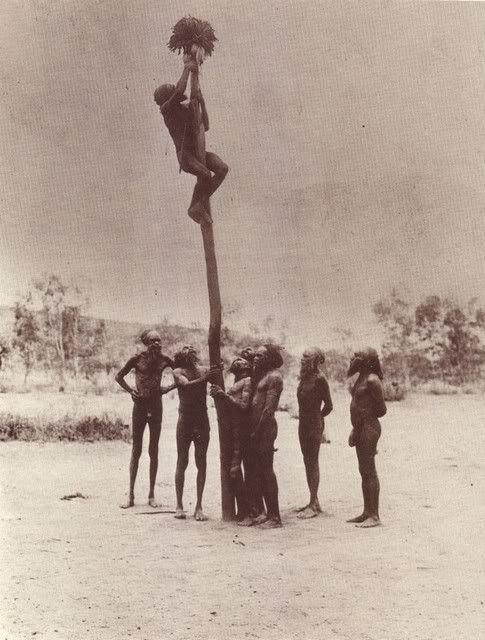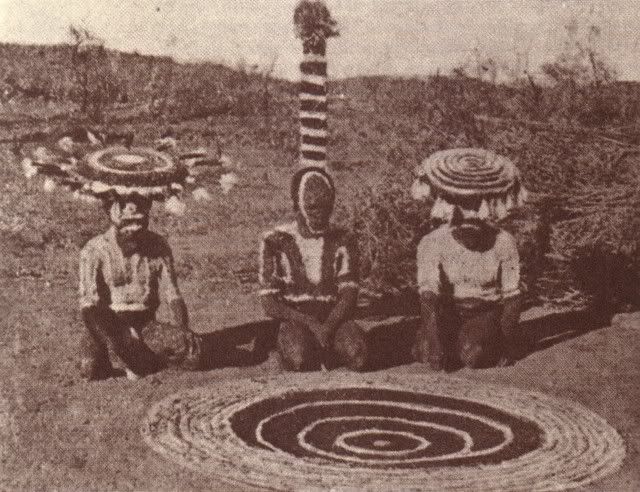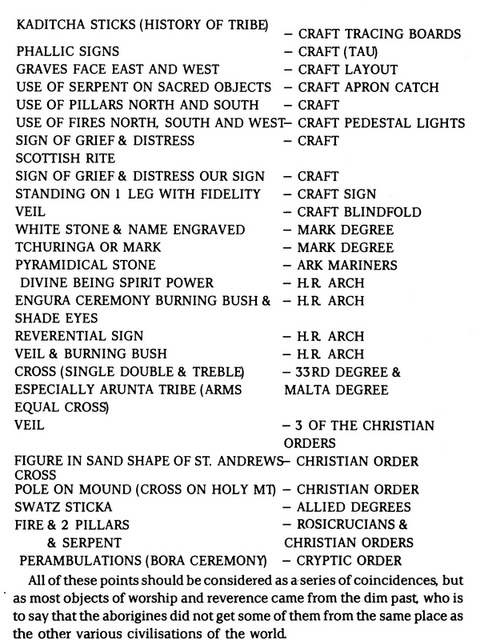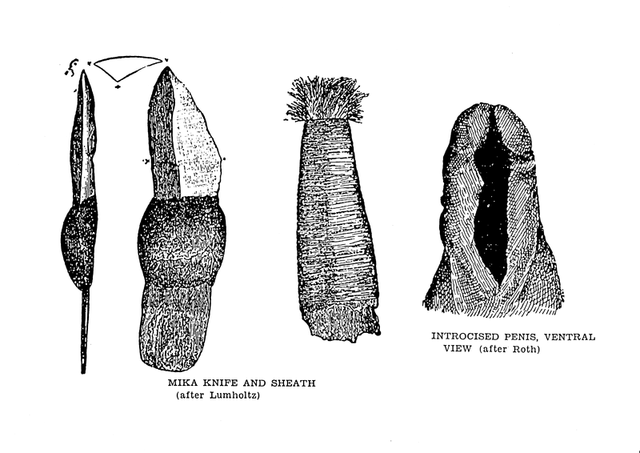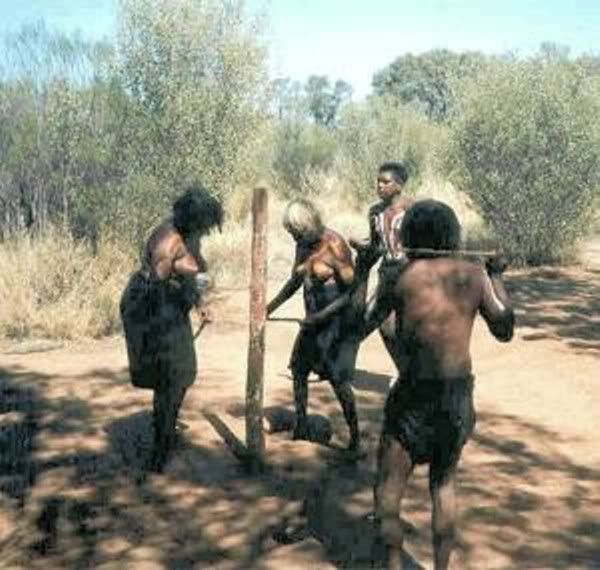|
|
Post by Tamrin on Aug 20, 2008 7:23:39 GMT 10
The Centre:Perhaps associated with the tree upon the Master's grave, among several tribes we find, in addition to the two posts marking the entrace to the Bora ground, a third, named pillar, pole or star post (Dixon & Duwell, pp.100/101). This was raised for the ritual in a third, tribal degree. In some cases, these poles were substantial and served as a 'ladder', which initiates climbed. Sir James Frazer said (1978, p.206) this post was " .... the most sacred object of the Arunta tribe in Central Australia...." It was often associated with the centre of a number of concentric rings. Professor Joseph Campbell (1976, p.113), says the pole was split into a male half and a female half and then bound, reuniting them. He also described (ibid., pp.114/5) the subsequent ceremony. His account was substantiated and more fully described by Robert Lawlor (pp. 107/8), as follows: In several tribes of north Arnhem Land, this ceremony makes use of a ground painting in which the first Creative Ancestor is represented by a large circle of concentric red and white rings.... The red rings are formed and hardened by earth mixed with blood that has been ritually extracted from the veins of initiated men. The white rings are also of blood and earth, but thousands of white bird feathers have been applied to their surface. From photographs of these rituals, there appear to be four wide inner circles and seven narrower outer circles.... The ceremony proceeds with three initiated men taking their place in the centre of a circle of young initiated men.... The tribal elder in the centre holds a large, heavy wooden pole that is also encircled from top to bottom with red and white colored rings. It has a crown of white feathers on top. The elder sits cross-legged with the pole in front of him; he raises and lowers it so that it pounds the earth. The pole is called Numbakul, which means the Eternal Naming....
The first line sung to the silent initiates is "May Numbakul reach to the stomach of the sky." This is sung as a mantra, alternating with "The earth is the stomach of the sky." As the sun sets the chanting stops. Assisted by the two men flanking him, the tribal shaman raises and lowers the pole, thumping the earth through the night. 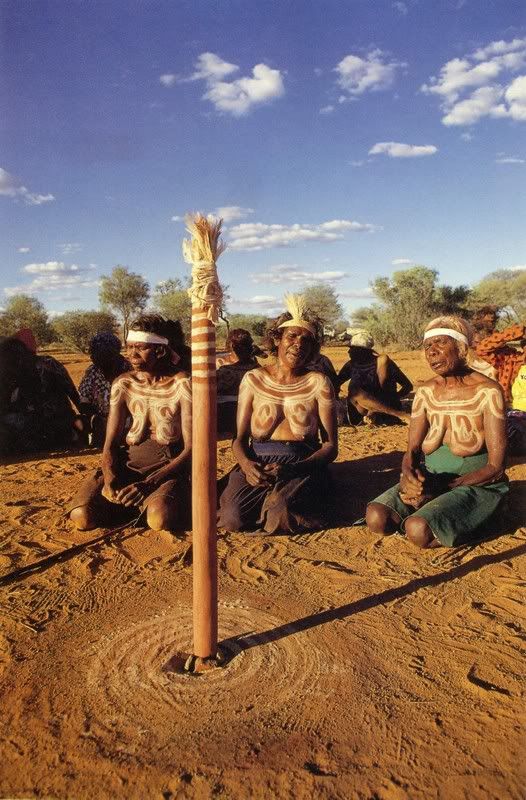 Joseph Campbell, 1976 (org. 1959), The Masks of God, Vol. 1, "Primitive Mythology," Penguin Books, Harmondsworth, UK R.M.W. (Bob) Dixon & Martin Duwell (Editors), 1990, The Honey-Ant Men's Love Song and other Aboriginal Song Poems, University of Queensland Press, St Lucia, Qld. James George Frazer, 1978, The Illustrated Golden Bough, (Mary Douglas, General Editor), Book Club Associates, London Robert Lawler, Robert, 1991, Voices of the First Day: Awakening in the Aboriginal Dreamtime, Inner Traditions, Rochester, USA
|
|
|
|
Post by Tamrin on Aug 20, 2008 18:51:17 GMT 10
Resurrection:Robert Lawlor wrote (p.185): " The effectiveness off initiation depends on the boys truly believing that he will, in the course of his initiation, encounter a Dreamtime power who will destroy him, and that after dying he will be restored to life." One wide-spread legend involves Baiame's son Dhuramoolan (Turner & Blyton; p.22), who was said to govern this process of being `born again'. We read (ibid): " Dhuramoolan pretended that he butchered the boys, burned them to ashes, moulded the ashes into a manly shape, and brought them back to life." As James Cowan stated (A, op. cit., p.7: " The ritual killing as an act varied in detail throughout Australia, although the principal motifs remained the same." Dr. Meggitt (op.cit., p.300) described how: " The lad, who wears a small apron ... , is told to kneel before the clearing...." Resuming Bro. McDonough's account (pp. 68/70), we find: At the age of 18-21 years he takes his final or 3rd degree:- He is led into their lodge and held in a kneeling position by his conductors, facing the East, and the Master of Ceremonies confronts him with the 2 ft. "KATITCHI" Stick, gives him a light tap on the left temple then a light tap on the right temple then brings it down with a terrific whack in the centre of his forehead laying him out cold. While he is unconscious the final painful markings are done and on his recovery he is shown the sign of grief and distress as we know it with his right hand, as he is indeed in distress [".... also those of Ascension and Descension...."] .... The reverential sign of the Holy Royal Arch is still given by the Arunta of Australia when he returns from his final degree through which he has passed in the mysteries of his initiation. Some tribes affirmed a great mystery, declaring (Havecker, p.70): " Illa Booker Mer Ley Urrie Urrie - The Soul Will Not Die!" Bro. Etheridge (p.24) quotes references to other signs, including: Dr. John Fraser relates an occurrence in the form of an "extract" from a private letter written by a Staff Surveyor in Queensland, to the effect that when on the Flinders and other rivers flowing into the Gulf of Carpentaria, in 1882-3, the blacks were very hostile. "One Sunday when we were resting in camp on Settlement Creek my horses began to gallop about furiously, a proof to me that the blacks were among them. The fight which ensued was short, sharp and decisive; at the end of it only one black was left, a very tall and powerful specimen, evidently a chief. I had just covered him with my rifle, and in another instant he would have dropped, when, to my utter astonishment, he gave me in rapid succession, three or four times, the P.S. of a M.M., and thereupon stood to order. I instantly answered him, and going nearer, I gave the Ss. of the E.A., F.C., and M.M., which he appeared to understand." The Staff Surveyor stated that, in the subsequent confusion, the native escaped. On a more positive note, Bro. Etheridge's cites the following account (pp.23/4): A somewhat remarkable occurrence is related by Governor Sir George Grey in his "Two Expeditions of Discovery in N.-W. and W. Australia," published in 1841. Grey met a party of natives in the Perth district, and after entering into friendly relations, an old woman recognised him as the "ghost" of a deceased son. Thereupon two men, one an old man, the father, and a younger one, the brother of the deceased, said the writer, "came up and embraced me in the following manner: they threw their arms around my waist, placed their right knees against my right knee, their breasts against my breast, holding me in this position for several minutes. Further sources:Cyril Havecker, 1987, Understanding Aboriginal Culture, (edited and foreword by Yvonne Malykke), Cosmos, Sydney John Turner & Greg Blyton, 1995, The Aboriginals of Lake Macquarie: A Brief History, Lake Macquarie City Council, Speers Point, NSW
|
|
|
|
Post by Tamrin on Aug 20, 2008 19:03:56 GMT 10
Distinguishing Badge:According to Jean Ellis (p.28): " The word bora .... means `belt of manhood', no doubt in reference to the fact that after initiation each young man would wear a loin-cloth-type girdle." The Bora itself is made of fur or hide, being a broad hip belt with a narrow `apron' of dingo-tail tassels or coloured string (ibid.). The Bora was the distinguishing badge with which initiates were invested. The Bora Ceremony and Bora Ground were its casual namesakes. Dr. Meggitt (p.283) wrote of a practice during the period of seclusion which accompanies a youth's initiation, whereby: " While he is in the bush, he wears only a hair-string cincture, but he dons a loin-cloth whenever he joins the men to witness ceremonies." Further source:Jean A. Ellis, 1994, Australia's Aboriginal Heritage, Collins Dove (HarperCollins), North Blackburn, Vic.
|
|
|
|
Post by Tamrin on Aug 21, 2008 6:58:37 GMT 10
Bora Ceremony:Each Candidate had already learnt legends such as how, " .... God had made man out of clay and blew into his nostrils to bring him to life and then made woman from parts of the man" (McDonough; p.68); that of a great flood (Gaster; pp.113/4); and how an ancestral adept isolated and saved his "people" from conflict by stretching forth his rod (a thigh bone), causing the sea to separate the land (Roberts & Roberts; p.14). Indeed (ibid.): The East Coast natives believe that their great spirit appeared accompanied by great flashes of lightning and bursts of thunder, on a great white stone of such brilliance that the eyes had to be shaded from the glare, and that he gave forth the laws to be followed for all time. In the Bora ceremony, each candidate, searching for "lost knowledge" (Ward, 1921, p.353; & Turner and Blyton, op. cit., p.22), was conducted under arches of boomerangs, held on either side by initiates, over a mound, shaped like a cross; (an `X' or St. Andrew's Cross), representing the cult hero Dhuramoolan, (Baiame's son). According to McDonough (p.70): The conductor leads the candidate through this arch and a word is demanded of him. He is threatened and challenged, is given and receives passwords and finally emerges into safety after having been conducted ... through dangers and difficulties to a new and enlightened existence. The blood of initiates is considered sacred and there are ceremonies which involve the comsumption of some. After being received into the circle of initiates, the candidates also shared bread, described by Harney (p.10) as follows: After eating of the Kerungera bread, a test of good faith, the ritual men give the "Outside' chant ... and then all are "clear" to return to their hunting grounds until the next Inma (Big Ritual). As Arthur Cotterell noted (p.225): " Not surprising, therefore, was the interest shown by the Australian Aborigines in the Christian communion rite when they learned about it from the first missionaries." Further sources:Arthur Cotterell, 1979, A Dictionary of World Mythology, Book Club Associates, London Theodor H. Gaster, 1975, Myth, Legend and Custom in the Old Testament: A Comparative Study with Chapters from Sir James G. Frazer's Folklore in the Old Testament, Harper Torchbooks (Harper & Row), New York W.E. Harney, n.d., Ritual and Behaviour at Ayers Rock, n.d., Australasian Medical Publishing Co. Ltd., Sydney, (reprinted from Oceania, Sept., 1960. V.31, No.1) Dale Roberts (text) & Ainslie Roberts (paintings), 1989, Shadows in the Mist: Australian Aboriginal Myths in Paintings, Art Australia, Blackwood, S.A. John Sebastian Marlow Ward, 1921, Freemasonry and the Ancient Gods, Simpkin, Marshall, Hamilton, Kent & Co., Ltd., London
|
|
|
|
Post by Tamrin on Aug 21, 2008 13:46:40 GMT 10
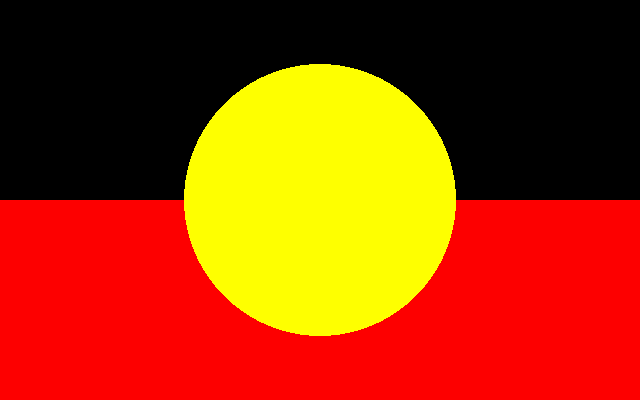 Aboriginal flag Aboriginal flag |
|
|
|
Post by Tamrin on Aug 22, 2008 6:57:56 GMT 10
McDonough cites many other correspondences between diverse aboriginal ceremonies and ours (p.73): |
|
|
|
Post by Tamrin on Aug 22, 2008 7:08:32 GMT 10
Women's Inclusion:Masonic authors generally overstate the exclusion of women from male initiations. Looking at their initiations, we find: - Some parts of male initiations depended on the active participation of women, including their performance of ritual and giving nourishment and instruction (Lawlor, pp.185, 188 & 191)
- The ultimate decision as to when each boy was ready for initiation was made by his mother or female relatives (Lawlor, p.184)
- The instructions, degrees and celebrations for women were similar to those for men except that the qualifications for women were not inflicted by fellow tribal members but by the great initiator—nature, (for example, menstruation and childbirth)
- Beyond the basic, tribal degrees were higher, intertribal degrees, open to both male and female elders
- According to wide-spread aboriginal tradition, the men's secrets were originally stolen from the women, (thus, women are said to be the ultimate source of these mysteries!)
- Deriving from the previous point, male ritual was centred around men emulating women (as will be explained next).
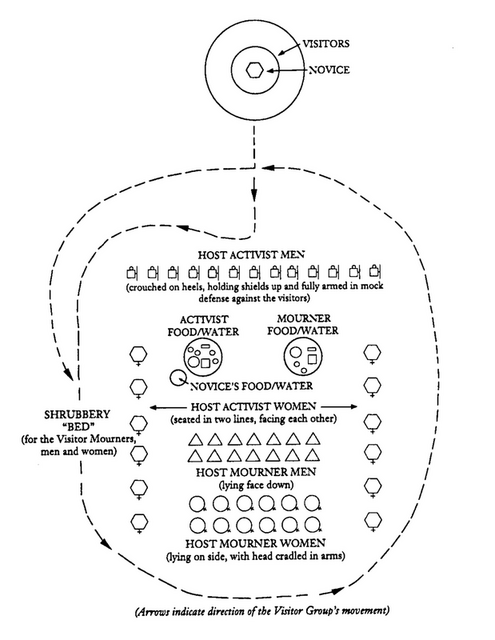 Perambulations, (demonstrating roles for both women and men) Perambulations, (demonstrating roles for both women and men)(Lawlor; p.191, after Tonkinson)
|
|
|
|
Post by Tamrin on Aug 24, 2008 21:38:47 GMT 10
Subincision:What is glossed over by most masonic authors are the huge difference between Aboriginal traditions and ours. One of these differences, which has received a great deal of attention by anthropologists, is the subincision, introcision or mika operation, as distinct from circumcision which is carried out as well (shortly before subincision). When and where practiced, there were variations (Bryk; p.131): Subincision may have been actual (as in central Australia); token (as in the bordering regions which only practice circumcision); or allegorical (as on the East and far West coasts). In all cases, circumcision and subincision was the point of and culmination of male initiations; in other words, their central landmark, of which they said, " Without the mika operation people are no better than dogs or other lower beings," (Bryk; p.129). " When questioned they reply, `That is the way our ancestors did, and so we have to do the same.'" (Davis; p.37). Rosalind Miles wrote (seemingly gleefully) of (pp.58/9): " .... the fate that befell every boy initiate in the Aranda tribe of Australia", only days after his initial circumcision: .... the ritual surgeon seizes the boy's penis, inserts a long thin bone deep into the urethra, and slashes at the penis again and again with a small piece of flint used as a scalpel. He cuts through the layers of flesh until he reaches the bone, and the penis splits open like a boiled frankfurter.
This hideous ceremony, christened 'sub-incision' by the white settlers, tormented their civilized minds—what possible purpose could it serve? Had they understood Aranda, all would have been clear. The Aboriginal word for 'split penis' derives from the term for the vagina, and the title `possessor of a vulva' [meko-maro among the Pitta-Pitta (Bryk; p.130)] is the honorific bestowed on all boys who undergo the ordeal. Later rituals also included the regular re-opening of the wound to demonstrate that the initiate could now 'menstruate'. It was, in Margaret Mead's words (Miles, p.59), "as if men can only become men by taking over the functions that women perform naturally.' We also read (Shuttle & Redgrove; p.66. Substantiated by Cotterell; p.227): Among the Australian Aborigines of Arnhem Land, their creation myth tells of the men stealing the magical instruments of the women, and the women being too busy with ordinary life to worry about this. There were two Wawilak sisters ... they still come to the men in dreams, to tell them how to do the circumcision dances. A native man commenting on these rites said: "We have been stealing what belongs to ... the Wawilak, the baby, the blood, the yelling, their danc¬ing, all that concerns the women ... In the beginning we had nothing... We took these things from the women." According to Arthur Cotterell (p.225): " The opening of this phallic womb is intended to make him more than a man.". Whereas, according to Robert Lawlor (p.194): The initial subincision provides an initiated man with a source of bloodletting for a number of rituals of increase throughout his life. In these rituals, men gather over the smoke of a fire and reopen the subincision with a thorn, so that blood splatters on their thighs as they perform fertility dances. Professor Joseph Campbell adds (1976, pp.102/3): The boy is lifted away and squats over a shield into which the blood is allowed to drain, while one or more of the younger men present, who have been operated on before, stand up and voluntarily undergo a second operation to increase the length of their incisions. These stand, hands behind their backs and legs wide apart close to the sacred pole, and shout, "Come and slit mine to the root!" According to Dr. Meggitt (pp.314/5), among the Walbiri: There is no sudden or marked change in a young man's ritual status following his subincision. For a year or two he continues to participate in the Gadjari rituals as a neophyte; he is still summoned to witness lodge ceremonies but cannot yet act in them. Nevertheless his lodge "brothers" and the Gadjari leaders now gradually divulge more religious information to him and, in their own time, allow him to take a minor part in ceremonies. It is not until he is betrothed, a couple of years after he has been subincised, that the men begin to regard him as an adult. Further Sources:Felix Bryk, 1974 (org. 1934), Circumcision in Man and Woman: Its History, Psychology and Ethnology, (translated by David Berger), Press, New York Rosiland Miles, 1989 (org. 1988), The Women's History of the World, Paladin Books (Collins), London Penelope Shuttle & Peter Redgrove, 1978, The Wise Wound: Menstruation & Everywoman, Victor Gollancz, London
|
|
|
|
Post by Tamrin on Aug 24, 2008 21:49:02 GMT 10
Stolen Secrets:An examination of the supposed origins and nature of the subincision operation adds meaningful depth to the exclusion of women from this part of male initiations. For instance, Monica Furlong reports (p.111/2): As in so many parts of the world, the ceremonies show a recognition of the power of women, along with many stories of power being taken from them. In the desert near Balgo it is said that in the mythical era women possessed all sacred ritual, only to have it taken by men. Among the Aranda, too, the same story is told of former equality and possession of sacred emblems. In the Great Victoria Desert, Ancestral Emu women are said to have taught the art of circumcision, replacing the dangerous method of the firestick with the better one of the stone knife. In Arnhem Land it is said that the Kangaroo Man invaded the women's camp while they were dancing, drove them out, took their sacred emblems, and began copying their motions and songs with his friends because they had none of their own.
The men had taken from them not only the songs, and the rituals, but also the power to perform sacred ritual, a power which had formerly belonged only to the Sisters. Before that, men had nothing. The elder Sister said '... Men can do it now, they can look after it ... We know everything. We have really lost nothing, because we remember it all, and we can let them have that small part. Aren't we still sacred, even if we have lost the baskets ...? Further source:Monica Furlong, 1996, Flight of the Kingfisher: A Journey Among the Kukatja Aborigines, HarperCollins Publishers, London
|
|
|
|
Post by Tamrin on Aug 25, 2008 7:11:50 GMT 10
Further to the earlier "Subincision' post, we read ( Graeme Powell, ABC News, Fri Oct 5, 2007): Man injures penis in botched initiation ceremony A 23 year old man is in a Perth hospital with serious injuries to his penis after an Aboriginal initiation ceremony went wrong.Police say the man approached a Kimberley elder yesterday and asked him to perform the ritual. The pair went to a park on Coode Street in Bayswater about 7.30pm last night where it is alleged the 50 year old man cut the younger man's penis twice with a razor blade. Police say the man lost around half a litre of blood and was taken to Royal Perth Hospital where he is in a stable condition. The older man has been charged with unlawful wounding. He is due to face court next Wednesday. |
|

